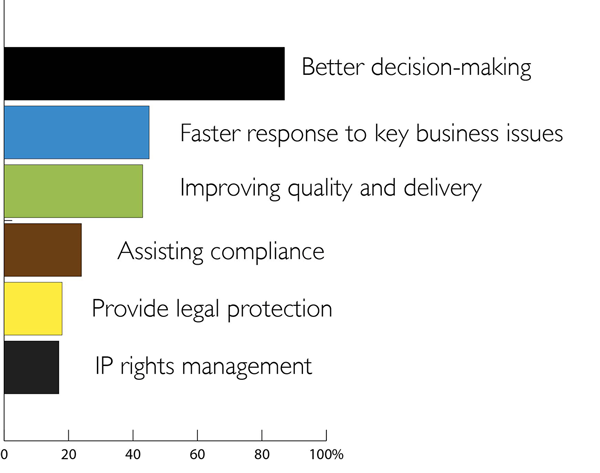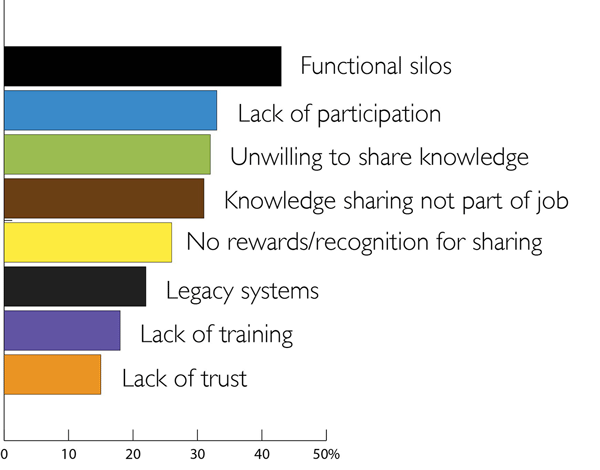Where to for Knowledge Management in 2015: IDM Reader Survey

What is knowledge management? This question has triggered a thousand on-line arguments and finding agreement on a single definition is a never-ending challenge. Ask the question and you might get answers like ”manage, plan, deploy, collect and spread knowledge in an organisation, and do it in a planned manner”, and ”to create, store, survey, use and revise knowledge”.
A survey of IDM’s readers found definite agreement on at least one thing, that the end goal of knowledge management should be “better decision-making”.
It’s perhaps unsurprising that of almost 90% of those surveyed, the bulk of whom came from medium to large enterprise and government organisations, right choices by knowledge workers emerged as the Holy Grail.
After all, we all know where wrong choices lead.
“KM is seen as irrelevant,” despaired one of our survey respondents, “In fact it is more relevant today than ever given enterprise applications, mobility and diverse teams”
Organisations know they need to enable knowledge transfer, but far fewer are engaging employees who possess critical knowledge, walking them through a consistent documentation and sharing process, and creating meaningful learning opportunities for knowledge recipients.
Content management and findability continue to be key focus areas for KM.
The types of initiatives that IDM readers are underway with in a quest to improve on their KM practices include rollouts or upgrades of SharePoint intranets, cloud-accessible process mapping, improved collaboration, communities of practice (COPS), Enterprise Search and People and Expertise directories.
One major Australian oil and gas exploration and production company with operations across the globe is trialling the use of Yammer for collaboration and idea exchange and using SharePoint for sharing and management of corporate information.
“KM initiatives are aimed at enabling the sharing of information freely and accessing knowledge and expertise through the use of CoPs sites. It helps the organisation in being able to access the many years of experience of key technical staff,” said the organisation’s Enterprise Systems Project Manager.
“The challenge is for staff being able to find the time to contribute and leverage the knowledge/information repositories and having technology systems that are intuitive putting the right information that their fingertips, instead of having to wade through the sea of information spam.”
Collaboration is the new normal
Technology is making it easier to integrate systems and connect across traditional boundaries, and social media has boosted people’s expectations for interaction and feedback. The result is that collaboration across the extended value chain is becoming the new normal.
“I think one of the biggest issues around knowledge is what we think we know but don’t,” said one knowledge manager at a large multinational.
“We have multiple capabilities for publishing details of what we think we know but these are not utilised. I have seen people shy away from sharing knowledge and speaking up as a more confident and yet less skilled individual disagrees with them.
“There is also a fair gap between knowledge of the theoretical and knowledge of how things actually work. It is easy to say we should assign metadata to information to increase its discovery but if that metadata should really be more of a folksonomy, some systems and approaches are far too restrictive to enable this. Semantics is also a big issue.”
The multinational is trying multiple approaches including SharePoint for an intranet, collaboration and blogs. Enterprise search is on the wish list for the Documentum user.
“We need better skill sharing across the globe and an increase in accountability. With a global organisation rumours are rife, the social collaboration platform, Jive, had enabled confirmation of the basis of the rumours. System and process support is also moving into a collaborative approach.”

What should be the end goal of an organisation’s KM strategies?
There are big changes ahead for the scope of knowledge sharing opportunities, when and where we access knowledge, and the toolkit for surfacing relevant information and expertise.
“The introduction of wikis has facilitated to some extent a collaborative tool; however, enterprise search engines tend to negate this initiative as it harvests more than aggregates knowledge pools,” noted a records manager at a leading Australian university.
“While Communities of Practice have been established their influence is minimal or restricted to areas rather than enterprise wide.”
“Knowledge management has probably lost it momentum as the so called measurement tools are really measuring best practice which in turn is an average. Perhaps the approach should be along the lines of “Communities of Process” where there is a common objective but various degrees and level of participation but collectively provide a knowledge pool,” he observed.
Setting up a wiki is often easy from a technology perspective, as many content management suites include the necessary tools, but getting authors and editors engaged may prove more daunting.
One IDM reader at a large Victorian government agency complains “Although a knowledge based business, the systems to support KM are not a core investment and the government trend is to reduce investment overall. There is a general lack of deep skills in KM. Holistic approaches are required to manage the processes that connect tacit, explicit and “potential knowledge”
The agency has adopted SharePoint for a staff intranet and to provide collaboration tools, enhanced by staff blogs on Yammer. It also employs a range of software and systems that support KM including metadata databases, standardised approaches to managing structuring, storing and with new work on management of release.
“KM ensures past research and work outputs can be integrated and accessed for future leverage. It is also critical in capturing required knowledge to ensure services and research findings in particular are defensible, recoverable and able to be exchanged.”
Matt Moore, manager in market operations at PricewaterhouseCoopers, thinks that knowledge managers need to pay attention to the emergent application of ideas from cognitive science and behavioural economics to the business world.
In Australia, he has seen organisations start to hire individuals with cognitive science and behavioural economics backgrounds, and they’ve begun to apply these approaches to “policy implementation, business improvement, and product development.”
Moore added, “If the KM community is just looking to manage SharePoint sites or Yammer communities and isn’t into this stuff, then we’ll be in even more trouble than we are now.”

What are the biggest barriers to knowledge retention?
One Australian Water Utility is linking Intranet documents from HP TRIM to the intranet to ensure most current versions are accessed.
“We are currently considering a project to clean up and move data from network drives and exchange server (email) into TRIM,” said the utility’s Records Administrator.
“KM provides lessons learned that can be used for future activities. It also saves time and reduces risk of error by compiling knowledge provided by others that have undertaken similar tasks before.
“Capitalising on the opportunities greatly depends on the organisational culture in relation to knowledge management and its value - particularly how it is viewed by those at the top.”
While survey respondents were in near universal agreement as to the aim of knowledge management, opinions on the main barriers to its implementation were more diverse. Functional silos were identified as the main culprit by almost half of those surveyed, while cultural roadblocks such as an unwillingness to share knowledge and inherent lack of participation were a close second. The use of legacy systems is often cited as a major obstacle by vendors of KM solutions but less than a quarter of those surveyed saw that as a problem.
“You have to have all staff on board to be fully successful. It’s hard to turn blue collar workers into caring white collar workers,” observed one respondent.
A typical approach to improving knowledge management is to implement a implement a Community of Practice (CoP) which is aimed at learning KM lessons from around the organisation, and to help to embed good KM practices. It is also used to identify issues preventing good practice and opportunities for improvements. This can be further enhanced with the deployment of dedicated team members to work with projects to distil the ‘knowledge nuggets’ out of projects, and to ensure that the key knowledge is retained in a useful, enduring manner.
One state government records manager is convinced it’s a central repository that is key.
“A single overriding environment is required which all other LOB packages use as their repository,” he recommends.
The organisation presently employs an Objective EDRMS with an Intranet and Wiki
“Using our existing infrastructure we support in excess of 1,000 users providing information to over Two Million consumers. This is a vast collection of brochures and forms both paper and virtual.”
One newly appointed KM Administrator in a legal department at an Australian oil and gas explorer, notes there are significant challenges with respect to ‘legacy’ systems and capturing backlog data. “Lack of direction from higher up the food chain can also be an issue, as well as focus and objectives being communicated - broadly.”
Some of the tools the organisation is utilising include the MAVIM BPM tool and SharePoint to create forums and collaborative spaces.
“We use KM to capture, develop, build and enhance information access and extractability. It aids in the development and implementation of integrated management systems; building policies, procedures, strategies, templates, etc.”
The legacy problem may not just apply to longstanding technology platforms, it can also apply to staff.
“I think there are challenges when it comes to organisations that tend to retain staff for long periods of time,” observed one local government records manager.
“It’s quite difficult making the transition into good records/information/knowledge management by all because traditionally we were an administrative heavy organisation with basically every department of the organisation having their own admin team. As result of this the people that have been in the organisation for 20+ years are often very unwilling to perform even basic tasks such as writing and posting letters, registering their own documents into the corporate EDRMS, and creating procedures for what they do, etc.”
Implementing Enterprise Search and metadata is not a panacea warns one of our survey respondents.
“If search and metadata are executed poorly, the requirement for structured, consistent indexing often negates the flexibility required to cater for the ever expanding types of knowledge collateral.”
Change management and system processes need to be as efficient and easy to use and possible or else adoption will need to be forced as the value is not readily apparent, warned another
“People need to appreciate the cost of poor knowledge capture and sharing and be made accountable for managing the knowledge assets they create or receive.”
One of the main facts playing against successful KM initiatives could be as one Information Manager points out, “I think a major problem is “business” as in we are all too busy.”
“KM is becoming critical as more employees retire and the workforce ages. The critical point is to capture by knowledge transfer especially tacit knowledge,” commented one NSW state government agency respondent. “However the challenge is gaining staff buy-in to use the systems and getting them to understand the need to record and transfer knowledge”
